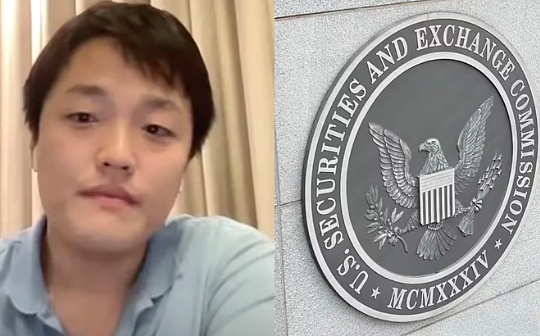
Author: daniel kuhn, coindesk; compile: Tao Zhu, Bitchain Vision Realm
The US Securities and Exchange Commission is seeking the strictest fine on the cryptocurrency project to date to date with a fine of $ 5.3 billion in DO KWON and Terraform Labs. Do Kwon and TerraForm Labs are the people and companies behind the stable currency of the stable currency.The internal explosion of the stable currency triggered a full -industry spread of billions of dollars.
Earlier this month, after conducting a protracted investigation and a relatively short two -week trial in New York, Kwon and TerraForm were found to have a fraud responsibility -covering the obvious danger of hidden in the transaction plan.Maintain the solvency of its USS stable currency, and the unsustainable 20%returns provided by Terraform’s Anchor loan platform.Last year, Kwon, who was arrested in Kuroshan, who held a fake passport in Kuroshan, did not attend the trial.He is currently waiting to extradite to the United States or his motherland South Korea.
The fine is not a matter of nailing on the board; the court will decide the final penalty.However, according to a court document on April 19, the US Securities and Exchange Commission stated that it sought “clear information”.
For experts, huge fines indicate that the SEC will not play again because SEC has proposed a $ 1.8 billion fine on Ripple.(Prior to this, the U.S. regulators fined the Binance Office of $ 4.3 billion. Although the SEC obviously did not participate in the settlement agreement, the prosecutor asked Zhao Changpeng, a former CEO of Binance this week for three years.)
Andrea Tosato, a assistant law at the University of Pennsylvania, said in an interview::“Recently against Terra/Do Kwon and Ripple’s highly noticeable cases, the penalty amount is as high as hundreds of millions or even billions of dollars, which indeed marked the change of the SEC strategy.”The committee seems to try to convey this kind of information … the return is not worthy of adventure. “
Although SEC Chairman Gary Gensler has been more or less opposed to cryptocurrencies since he took office in 2021, the financial massacre caused by the closure of Terra, San Arrow Capital and FTX in 2022 has made the industry participate in participating in the industry to participate inCome in to become a national priority.For example, the Bayeng government issued a memorandum, pointing out that supervision cryptocurrencies would be a “entire government” affairs.
Therefore, Binance, Ripple, and current Kwon and Terraform all feel the importance of this.
Although Lawyer TerraForm argued that the United States lacked jurisdiction, they now argued that the fines for fines were limited to $ 3.5 million.Kwon’s National Defense Commission recommends a fine of only $ 1 million.Ripple proposed a civil fine of no more than 10 million US dollars, thinking that the SEC’s proposed fine is too high, because this is far more than 20 times the fine received from cryptocurrency reconciliation.
To some extent, it is true.The US Securities and Exchange Commission has received more than $ 1.2 billion in funds from Telegram, but almost all the amount will be returned to investors, and this popular communications company only needs to pay $ 18.5 million in civil fines.This is consistent with Block.one’s US $ 24 million in 2019.(Coindesk is owned by Bullish, and Bullish holds a majority equity by Block.one.) In 2022, the US Securities and Exchange Commission (SEC) revenue from law enforcement operations was 6.4 billion U.S. dollars.The average civil fine is slightly higher than $ 9 million.
So, what caused the seemingly aggressive transformation of the SEC?Yuliya Guseva, a professor at Rogers University School of Law, said that this may be the result of a comprehensive role of various factors, including the possibility of illegal income increased with the expansion of cryptocurrency projects.But there is also a legal strategy of “horror”, which is to be afraid of the entire industry to motivate compliance.
GUSEVA said in an interview:“The latter approach shows that the choice of the SEC may be strategic because it tries to incorporate the cryptocurrency industry into the scope of the securities law.”
TOSATO said that the securities law has not actually mentioned the return of illegal income, but since the 1970s, returning has always been a standard operating procedure, as a way to return funds to investors and prevent future violations.On the other hand, civil penalties should follow the rules manual, including the degree of illegal degree, the actual (or potential) damage caused by investors, and the degree of the defendant complied with the regulatory agency.
However, in practice, this process “does involve a certain degree of freedom of discretion that the US Securities and Exchange Commission exercises a certain degree of free tailoring within the established legal framework.” TOSATO added.Although increasing the company’s fine amount is definitely to convey a message to others, TOSATO said he did not do this.When it comes to obvious cases of fraud and securities violations, do not think that the US Securities and Exchange Commission is “particularly inconsistent with what it has done in other industries” -the many cases.
“In my opinion, the difference is,The applicability of the regulatory framework in the cryptocurrency sector is much greater than the uncertainty of many industries,,“TOSATO said.” The recent jurisprudence still leaves many unreasonable problems.”








